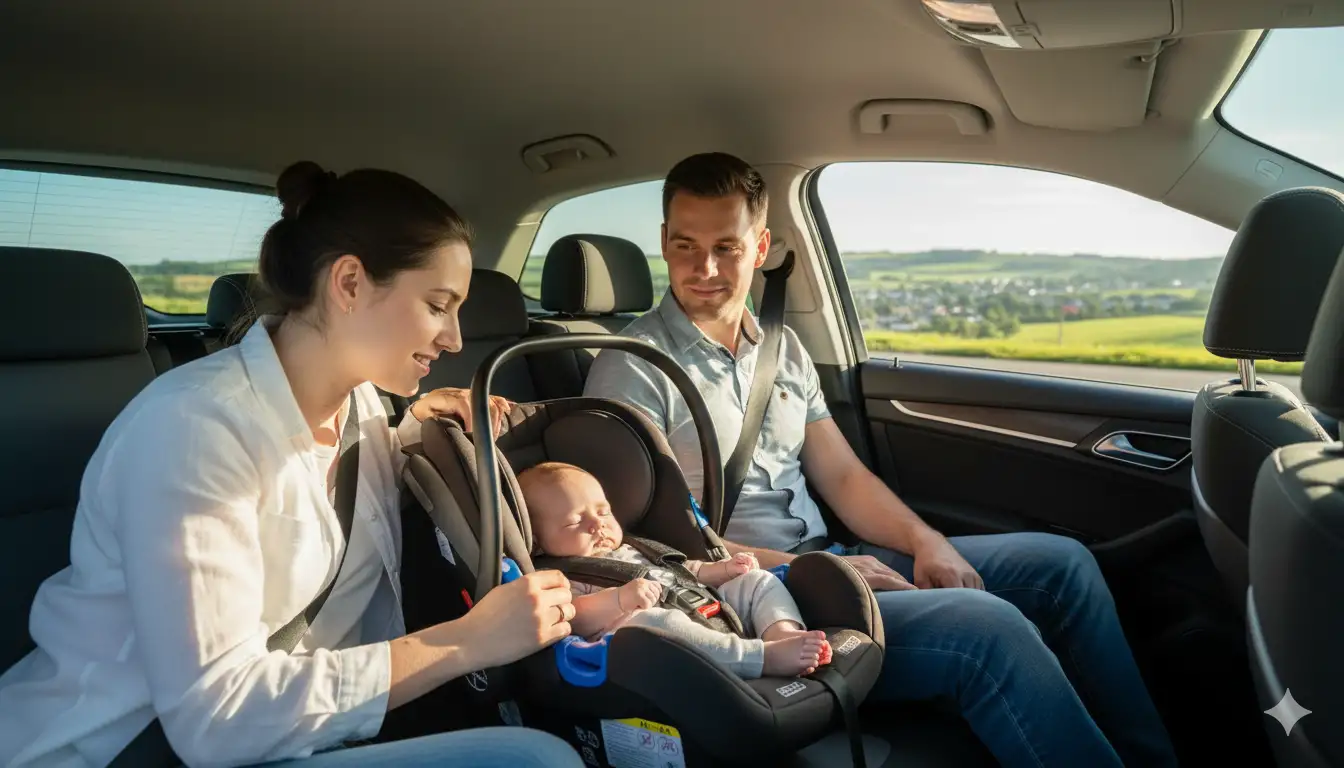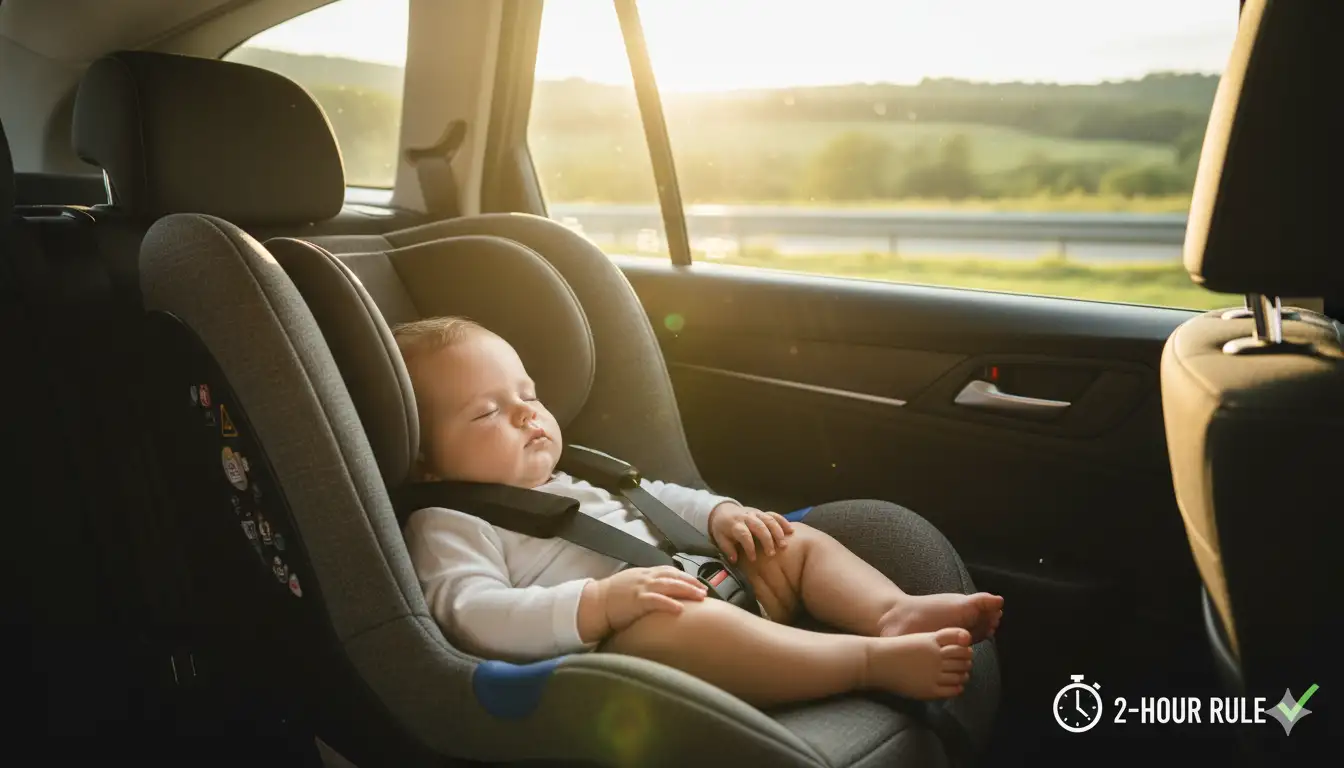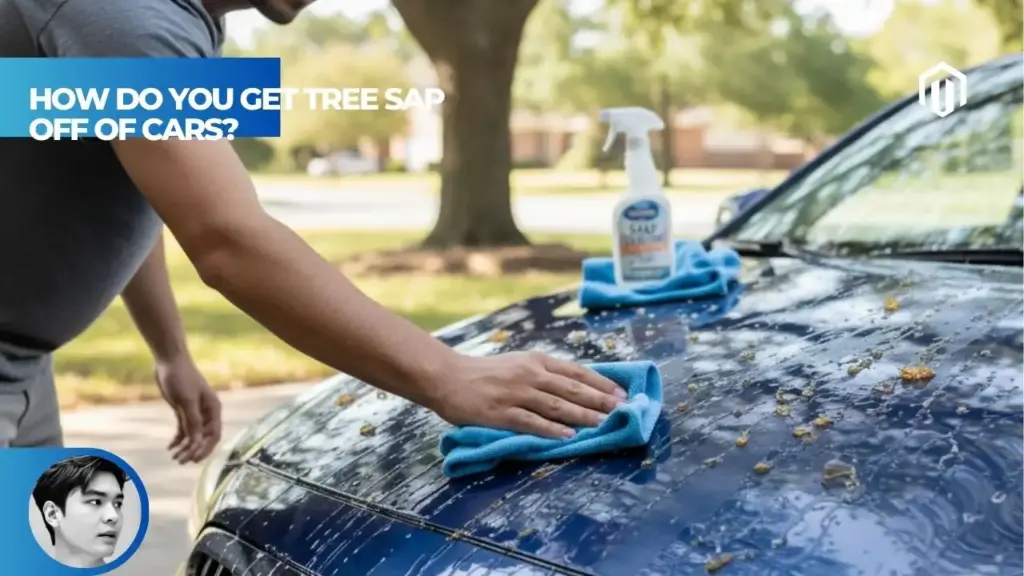You may also like:
- 【Explained】Where Is the Expiration Date on a Car Seat?
- 【Explained】When to Take Newborn Insert Out of Car Seat? (The Manufacturer’s Manual is Key)
- 【Explained】How to Put Infant Car Seat on Shopping Cart? Safety First
- 【Explained】What Happens When Your Car Is Totaled But Still Drivable?
- 【Review】Top 7 Best Ways to Clean a Car After a Body Repair
The 2-hour car seat rule effectively ends when babies develop full head and neck control and can sit up unassisted, typically around 6 months of age. While the strict time limit becomes less critical after this developmental milestone, experts still recommend taking regular breaks every 1.5-2 hours during long journeys for comfort, circulation, and safety throughout childhood.
As new parents navigate the complexities of infant safety, understanding when and why car seat time limits change helps ensure both protection during travel and healthy development. The transition from strict time limits to more flexible guidelines depends entirely on your baby’s individual physical capabilities rather than a specific age.

Understanding the 2-Hour Car Seat Rule and When It Ends
The Rule Ends at 6 Months with Head and Neck Control
The 2-hour rule becomes less urgent when babies reach approximately 6 months of age and demonstrate consistent head and neck control[1]. This critical milestone marks when infants can maintain their airways open without the constant risk of their heads falling forward and restricting breathing.
According to the American Academy of Pediatrics, babies typically achieve this developmental checkpoint between 4-6 months, though individual variation is normal. Some babies develop these skills earlier at 4 months, while others may take until 7 months to fully master head control. The key indicator isn’t age but rather the physical ability to hold their head steady without support.
Autvex child safety experts emphasize that parents should observe their baby’s specific development rather than relying solely on age guidelines. When your baby can sit with minimal support and their head doesn’t wobble or fall forward when upright, they’ve reached the point where extended car seat use becomes significantly safer.
Developmental Milestones That Signal Rule Relaxation
Several interconnected milestones indicate when the strict 2-hour limit can be cautiously relaxed. The primary indicator is independent sitting ability, typically achieved between 4-6 months[2]. This skill demonstrates sufficient core strength and neurological development to maintain safe positioning.
Key milestones to watch for include:
- Holding head steady when pulled to sitting position
- Rolling from back to stomach and returning
- Sitting without support for several seconds
- Maintaining head control during movement
- Showing strong neck muscles during tummy time
Parents often notice these developments gradually rather than suddenly. Your baby might first sit steadily for a few seconds, then progress to minutes, before achieving confident independent sitting. Each stage represents improved safety for car seat use, though the 2-hour guideline remains a helpful framework even after these milestones.
Why the 2-Hour Rule Exists for Baby Safety
The 2-hour rule exists primarily to prevent positional asphyxiation, a serious risk where babies’ airways become compromised due to head positioning[3]. Infants’ disproportionately large heads combined with weak neck muscles create vulnerability when seated at an incline for extended periods.
Car seats, while essential for crash protection, position babies at an angle that can cause their heavy heads to fall forward. This chin-to-chest position potentially restricts airflow through the windpipe, particularly dangerous for babies who lack the strength to reposition themselves. Studies have shown that even properly installed car seats can lead to oxygen saturation drops in some infants during extended use.
Beyond breathing concerns, prolonged car seat use affects spinal development and circulation. The semi-reclined position places pressure on the developing spine, while restricted movement can impact blood flow. These factors combined make the 2-hour limit a crucial safety measure during early infancy.
Car Seat Time Limits by Age
Newborn Travel: The Strict 30-Minute Rule (0-4 Weeks)
Newborns face the strictest limitations, with many experts recommending maximum 30-minute periods in car seats during the first four weeks of life[4]. This ultra-cautious approach reflects newborns’ extreme vulnerability, with airways as narrow as drinking straws and virtually no head control.
Premature babies face even stricter guidelines, often requiring car seat tolerance tests before hospital discharge. These tests monitor oxygen levels and heart rate during a 90-minute period to ensure the baby can safely travel home. For families purchasing vehicles before baby’s arrival, understanding these limitations helps plan for necessary stops during the journey home from the hospital.
| Age Range | Maximum Time | Break Duration | Key Concerns |
|---|---|---|---|
| 0-2 weeks | 30 minutes | 15-20 minutes | Critical airway risk |
| 2-4 weeks | 30 minutes | 15 minutes | Very limited neck strength |
| 1-2 months | 45-60 minutes | 15 minutes | Developing muscle control |
| 2-4 months | 90-120 minutes | 15 minutes | Improving but still vulnerable |
Early Infancy: 2-Hour Limit (1-4 Months)
Between one and four months, the standard 2-hour maximum becomes the primary guideline, though this represents continuous time in the seat rather than total daily exposure[1]. This period sees rapid development but infants still lack sufficient strength for extended upright positioning.
During this stage, babies begin showing improved head control during supervised tummy time but remain vulnerable when seated. The 2-hour limit applies whether the car seat is in the vehicle, attached to a stroller as part of a travel system, or being used as a carrier. Many parents don’t realize that time spent in the car seat outside the vehicle counts toward this limit.
Real-world application means planning stops during longer journeys. A three-hour trip requires at least one 15-20 minute break where baby is removed from the seat entirely. These breaks serve dual purposes: allowing the baby to stretch on a flat surface and giving parents opportunity to check positioning and comfort.
After 6 Months: Extended Travel Becomes Safer
Once babies reach 6 months with established head control and sitting ability, the strict 2-hour rule transitions to a more flexible guideline[5]. While extended travel becomes safer, experts still recommend breaks every 1.5-2 hours for comfort and development.
At this stage, babies can typically:
- Maintain upright head position even when drowsy
- Adjust their position slightly for comfort
- Signal discomfort more effectively
- Tolerate longer periods without breathing concerns
However, “safer” doesn’t mean unlimited time is appropriate. Extended car seat use still restricts movement essential for developing motor skills and can cause discomfort from prolonged positioning. Parents transitioning to longer trips should gradually increase duration while monitoring their baby’s tolerance.
Critical Developmental Milestones for Car Seat Safety
Head Control and Neck Strength Development
Full head control represents the single most important milestone for car seat safety, typically achieved between 4-6 months of age[2]. This development involves complex coordination between neck muscles, core stability, and neurological maturation.
Progressive stages of head control include:
- Brief lifting during tummy time (2-3 months)
- Steady holding when supported sitting (3-4 months)
- Controlled movement side to side (4-5 months)
- Full control in all positions (5-6 months)
Parents can assess head control by gently pulling baby from lying to sitting position. If the head lags significantly behind the body or flops backward, more development is needed. When the head moves smoothly with minimal lag, staying aligned with the spine, sufficient control has developed for safer extended car seat use.
Sitting Up Unassisted as Key Indicator
Independent sitting ability, achieved around 6 months for most babies, signals readiness for relaxed car seat time limits[1]. This milestone requires coordination of multiple muscle groups and balance systems, indicating overall readiness for maintaining safe positioning.
The progression to independent sitting follows predictable patterns:
- Tripod sitting with hand support (4-5 months)
- Brief unsupported sitting (5-6 months)
- Confident sitting while playing (6-7 months)
- Transitioning in and out of sitting (7-8 months)
Sitting ability directly correlates with car seat safety because it demonstrates core strength necessary to maintain airway-protective positioning. Babies who can sit independently can also better adjust their position when uncomfortable, reducing risk of remaining in dangerous positions.
Age-Appropriate Travel Guidelines
Travel recommendations evolve with developmental stages, requiring parents to adapt their approach as babies grow. Understanding age-appropriate guidelines helps balance safety with practical travel needs.
- 0-3 months: Minimize travel when possible, strict adherence to time limits
- 3-6 months: Gradual increase in tolerance, maintain 2-hour maximum
- 6-12 months: Flexible approach with regular breaks
- 12+ months: Focus shifts to comfort and movement needs
For families with larger vehicles like the BMW X5 that accommodate multiple car seats, understanding these guidelines becomes crucial when traveling with children of different ages, each requiring different break schedules.

Health Concerns Behind the 2-Hour Rule
Positional Asphyxiation Risk in Car Seats
Positional asphyxiation occurs when a baby’s body position restricts breathing, with car seats presenting particular risk due to their necessary incline angle[6]. This silent danger can develop gradually, making awareness and prevention critical for infant safety.
The mechanics of positional asphyxiation involve:
- Head falling forward, chin touching chest
- Airway compression from neck flexion
- Gradual decrease in oxygen levels
- Inability to self-correct positioning
Research indicates that even properly installed car seats at the recommended 45-degree angle can cause oxygen desaturation in some infants. Premature babies and those with respiratory conditions face heightened risk, requiring extra vigilance and potentially shorter time limits.
Warning signs include unusual quietness, color changes around lips, labored breathing sounds, or excessive sweating. If any concerns arise, immediately stop the vehicle safely and reposition the baby on a flat surface.
SIDS Risk and Breathing Difficulties
While car seats themselves don’t cause SIDS, prolonged use in semi-upright positions may contribute to breathing difficulties that increase risk factors[7]. The relationship between sleep position and SIDS has led to strict recommendations about car seat use for routine sleep.
According to Autvex safety consultants, the safest sleep environment remains a firm, flat surface in a crib or bassinet. Car seats should never substitute for proper sleep surfaces, even for short naps at home. This guideline applies equally to other inclined products like swings and bouncers.
Studies have documented concerning statistics:
- 3% oxygen saturation decrease in some newborns after 60 minutes
- Doubled risk of breathing events in premature infants
- 40% of car seat deaths occur outside vehicles
These findings reinforce why the 2-hour rule exists and why car seats should strictly serve their intended purpose: safe vehicle travel.
Spinal Development Considerations
Extended car seat use impacts spinal development, particularly during the first year when the spine undergoes rapid growth and curvature formation[4]. The C-shaped curve present at birth gradually develops into the adult S-curve through movement and position changes.
Car seats maintain babies in a semi-reclined position that, while necessary for safety, doesn’t support optimal spinal development when used excessively. The restricted movement prevents natural stretching and strengthening activities crucial for proper musculoskeletal development.
Long-term concerns from excessive car seat use include:
- Delayed motor milestone achievement
- Potential for plagiocephaly (flat head syndrome)
- Hip development issues from prolonged hip flexion
- Core weakness from lack of movement variety
Balancing travel safety with developmental needs requires conscious effort to minimize unnecessary car seat use while ensuring proper protection during vehicle travel.
Safe Travel Practices After the Rule Relaxes
Taking Regular Breaks Every 1.5-2 Hours
Even after the strict 2-hour rule ends, maintaining a schedule of breaks every 1.5-2 hours benefits both safety and comfort[8]. These stops serve multiple purposes beyond just removing baby from the car seat.
Effective break strategies include:
- Plan stops at safe locations with space to lay baby flat
- Allow 15-20 minutes minimum for each break
- Combine with feeding times for efficiency
- Use breaks for diaper changes and comfort checks
- Include adult stretching to maintain driver alertness
For longer journeys, consider overnight stops to maintain normal sleep routines. While vehicles with excellent rear climate control improve comfort, they don’t eliminate the need for regular movement breaks.
Transferring Baby to Flat Surface When Stopped
Upon reaching any destination, immediately transferring baby from car seat to a flat surface remains best practice regardless of age[1]. This simple action prevents the common but dangerous practice of allowing extended sleep in car seats outside vehicles.
Appropriate flat surfaces include:
- Firm crib or bassinet mattress
- Play yard with proper mattress
- Blanket on floor for supervised play
- Changing table for brief periods
The temptation to leave sleeping babies in car seats is understandable but risky. Studies show that most car seat-related deaths occur when seats are used outside vehicles for extended sleep. Even older babies who’ve passed the 6-month threshold shouldn’t routinely sleep in car seats when alternatives exist.
Avoiding Car Seat Sleep Outside the Vehicle
Car seats should never serve as sleep surfaces outside their intended vehicle use, a guideline that remains constant regardless of baby’s age[9]. This restriction applies to car seats used as carriers, attached to strollers, or simply placed on floors at home.
Common scenarios to avoid:
- Bringing sleeping baby inside in car seat after drive
- Using travel system for extended stroller naps
- Placing car seat in crib as sleep surface
- Overnight sleep in car seat during travel
If baby falls asleep during a car journey, transfer them to an appropriate sleep surface upon arrival, even if it means waking them temporarily. The safety benefits far outweigh the inconvenience of disrupted sleep.
Long Car Journeys with Babies and Toddlers
Road Trip Planning with Infants
Successful road trips with infants require careful planning around the 2-hour rule and developmental considerations. Strategic scheduling can make longer journeys manageable while maintaining safety standards.
Effective planning strategies:
- Map stops every 90 minutes allowing buffer time
- Research baby-friendly rest areas with changing facilities
- Plan longer breaks during normal wake windows
- Consider splitting very long trips over multiple days
- Pack portable sleep surfaces for extended stops
Timing departure around baby’s sleep schedule can maximize driving time, though never compromise safety for convenience. Early morning departures often work well, allowing one longer stretch during morning nap before needing the first break.
Travel System Use and Safety
Travel systems combining car seats with strollers offer convenience but require understanding of time limit applications[2]. The 2-hour rule applies to total time in car seat, whether in vehicle or attached to stroller base.
Safe travel system use involves:
- Tracking total time from car seat entry
- Using stroller bassinet attachments when available
- Removing baby from car seat between car and destination
- Avoiding extended shopping trips with baby in car seat
- Considering baby-wearing as alternative for errands
Many parents don’t realize that a 30-minute drive followed by 90 minutes of errands with baby in the travel system equals the full 2-hour limit. Breaking this pattern requires conscious effort but protects baby’s health.
Extended Car Seat Use Guidelines
As children grow beyond infancy, car seat use guidelines shift focus from breathing concerns to overall comfort and development[5]. Toddlers and preschoolers still benefit from regular breaks despite no longer facing positional asphyxiation risks.
Age-adjusted guidelines for extended travel:
- 12-24 months: Break every 2 hours for movement
- 2-4 years: Stop every 2-3 hours for bathroom and activity
- 4+ years: Follow adult break schedule (every 2-3 hours)
Even older children in booster seats need regular opportunities to move and stretch. Extended sitting can cause discomfort and restlessness that makes travel unpleasant for everyone. Planning age-appropriate activities during breaks keeps children engaged and helps reset attention spans for continued travel.
Special Considerations for Premature Babies
Preemie Care and Stricter Time Limits
Premature babies face unique challenges requiring even stricter adherence to time limits, often with maximum 30-minute periods regardless of adjusted age[4]. Their underdeveloped respiratory systems and weaker muscle tone create heightened vulnerability.
Special considerations for preemies include:
- Hospital car seat challenge test before discharge
- Possible need for car bed instead of traditional seat
- More frequent monitoring during travel
- Extended application of newborn guidelines
- Coordination with NICU follow-up team
Parents of premature babies should work closely with their healthcare team to establish appropriate travel guidelines. Some preemies may need specialized positioning devices or rolled blankets for additional support, though these should only be used under medical guidance.
When to Stop Immediately If Baby Slumps
Recognizing when immediate intervention is necessary can prevent serious complications. If baby slumps forward with chin touching chest, stop the vehicle safely and immediately reposition[3].
Critical warning signs requiring immediate action:
- Head falling forward despite proper recline
- Color changes (pale, gray, or blue tinting)
- Unusual breathing sounds or patterns
- Excessive sweating without obvious cause
- Lack of response to gentle stimulation
Never attempt to adjust baby’s position while vehicle is moving. Find the nearest safe location to stop, even if this means exiting at an unexpected location. The few minutes to reach a proper stopping point aren’t worth risking breathing complications.
Consulting Medical Providers for Guidance
Individual medical guidance trumps general guidelines, particularly for babies with special healthcare needs[10]. Conditions affecting breathing, muscle tone, or neurological function may require customized travel restrictions.
Discuss with healthcare providers:
- Specific time limits for your baby
- Signs to monitor during travel
- Emergency response plans
- Equipment modifications needed
- When to reassess restrictions
Documentation from medical providers can be helpful when explaining necessary stops to employers or when planning travel logistics. Some families benefit from written travel plans outlining specific requirements and emergency procedures.

Key Takeaways
- The 2-hour rule relaxes around 6 months when babies achieve head control and independent sitting
- Newborns under 4 weeks should limit car seat time to 30 minutes maximum
- Positional asphyxiation risk drives strict limits until neck strength develops
- Regular breaks every 1.5-2 hours remain important even after 6 months
- Never use car seats for sleep outside vehicles regardless of age
- Individual development matters more than specific age milestones
- Premature babies require stricter limits and medical guidance for travel
Next Steps
Begin monitoring your baby’s developmental progress through daily tummy time sessions, noting improvements in head control and trunk stability. Document milestones like independent sitting to discuss with your pediatrician during well-child visits. These observations help determine when your specific child can safely handle longer car seat periods.
Plan upcoming travel with appropriate break schedules based on your baby’s current developmental stage. For infants under 6 months, map rest stops every 90 minutes along your route, researching facilities that provide safe spaces for baby care. Consider breaking longer journeys into manageable segments rather than pushing time limits.
Install Autvex’s recommended car seat monitoring apps or set phone timers to track time in seat, ensuring you don’t inadvertently exceed safe limits during busy days. Create a travel kit with portable changing pad and blanket for comfortable break areas. Most importantly, trust your instincts—if baby seems uncomfortable or distressed, take a break regardless of elapsed time. Safety always supersedes schedule convenience when traveling with infants.
Frequently Asked Questions
At what age does the 2-hour car seat rule end?
The 2-hour rule becomes less strict around 6 months when babies develop full head and neck control and can sit unassisted, though regular breaks every 1.5-2 hours are still recommended for all children during long trips.
Is the 2-hour car seat rule only for newborns?
The rule is most critical for newborns and young infants under 4-6 months who lack muscle control to maintain safe positioning, but applies to all babies who cannot sit unassisted regardless of exact age.
How long can a baby be in a car seat after 6 months?
After 6 months, babies can tolerate longer periods in car seats, but breaks every 1.5-2 hours are still recommended for stretching, movement, comfort, and healthy development during extended travel.
How long can a newborn stay in a car seat?
Newborns, especially in the first 4 weeks, should limit car seat time to 30 minutes maximum due to their very small airways and complete inability to hold their heads up or reposition themselves.
What is the car seat time limit for babies?
Generally 2 hours maximum for babies under 6 months, with stricter 30-minute limits for newborns under 4 weeks, gradually relaxing as babies develop head control and sitting ability around 6 months.
Is it safe for a baby to sleep in a car seat?
Car seats should only be used for transport while the vehicle is moving. Babies should not sleep in car seats outside the vehicle and should be transferred to a flat, firm surface upon arrival at any destination.
Why is there a 2-hour rule for car seats?
The rule prevents positional asphyxiation, breathing difficulties, and spinal issues that can occur when babies without adequate head control slump forward in semi-reclined seated positions for extended periods.
What is positional asphyxiation in a car seat?
Positional asphyxiation occurs when a baby’s head falls forward in a car seat, causing their chin to touch their chest and restrict the airway, potentially leading to breathing difficulties or oxygen deprivation—particularly dangerous for infants lacking head control.
What should I do on a long car trip with a baby?
Take 15-20 minute breaks every 1.5-2 hours to remove baby from the seat, allow them to lie flat for stretching, complete feeding if needed, and never use the car seat for sleep once you’ve reached your destination.
References
- Orbit Baby. (2025). Car Seat Safety: What is the 2-Hour Rule and When Does it End. https://orbitbaby.com/blogs/news/when-does-the-2-hour-car-seat-rule-end
- Evenflo. (2024). How to Prepare for the 2 Hour Car Seat Rule. https://www.evenflo.com/blogs/evenflo-blog/preparing-for-the-two-hour-drive-limit
- Sleepy Angels Consultancy. (2025). Car Seat Time Limit for Babies: the 2 hour rule explained. https://sleepyangelsconsultancy.com/car-seat-time-limit-for-babies/
- River Baby Group. (2025). Parent FAQs: What Age Does the 2-Hour Car Seat Rule End? https://www.riverbabygroup.com/what-age-does-the-2-hour-car-seat-rule-end/
- Safe in the Seat. (2025). Baby’s First Car Ride Home. https://www.safeintheseat.com/post/babys-first-car-ride-home
- Fundacion Mapfre. (2024). What is positional asphyxiation? https://www.fundacionmapfre.org/en/blog/positional-asphyxia/
- Safe in the Seat. (2025). Everything You Need to Know About Sleeping in a Car Seat. https://www.safeintheseat.com/post/everything-you-need-to-know-about-sleeping-in-a-car-seat
- NHTSA. (2022). Car Seat & Booster Seat Safety, Ratings, Guidelines. https://www.nhtsa.gov/equipment/car-seats-and-booster-seats
- Good Morning America. (2019). My son died from positional asphyxia in a car seat. https://www.goodmorningamerica.com/family/story/son-died-positional-asphyxia-car-seat-parents-66285041
- Oklahoma State Extension. (2017). Protecting Infants and Toddlers from Positional Asphyxia. https://extension.okstate.edu/fact-sheets/protecting-infants-and-toddlers-from-positional-asphyxia-car-seats-and-sling-carriers.html

I am a senior automotive analyst at Autvex. Expert vehicle evaluations, in-depth reviews, and objective analysis helping readers make informed automotive decisions with years of industry experience.









